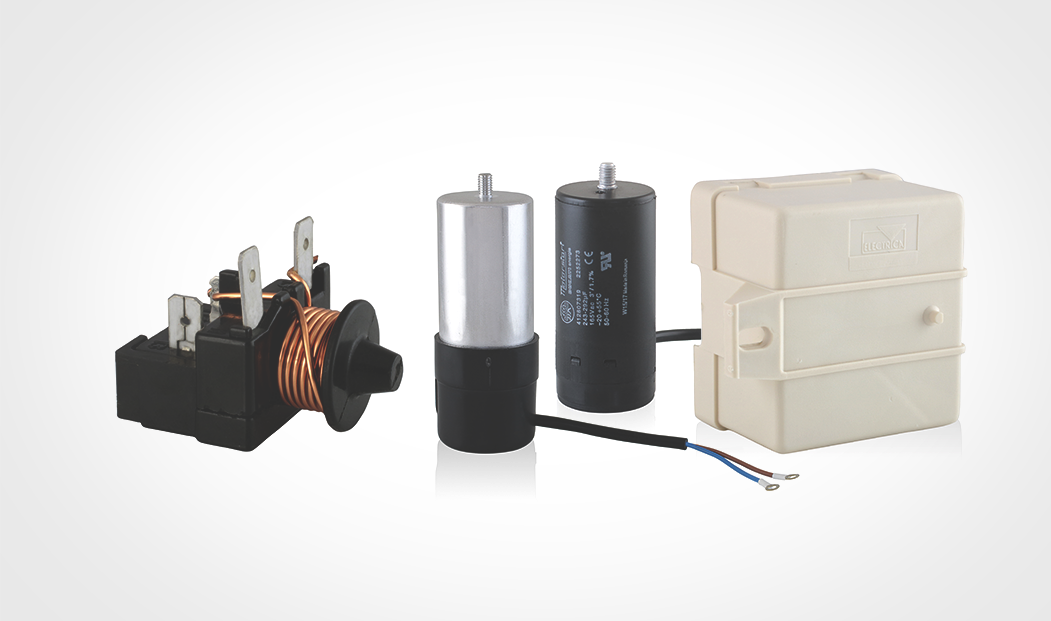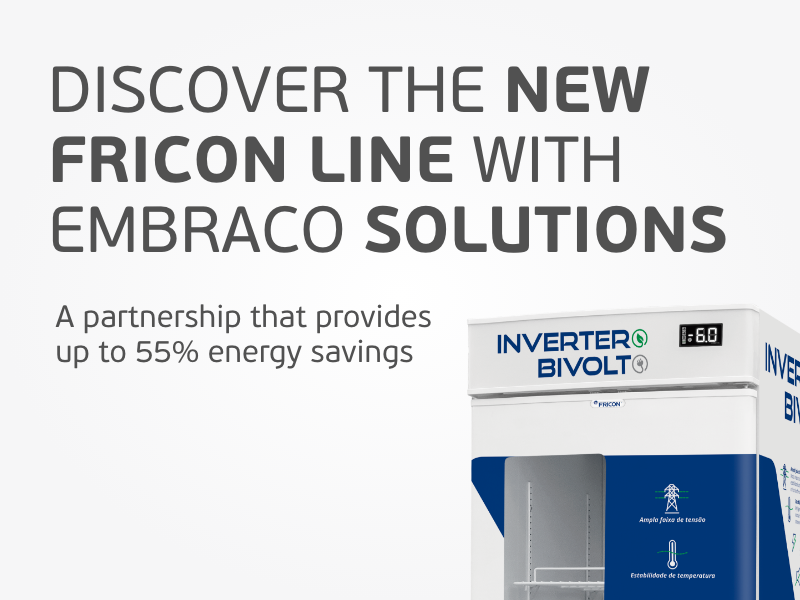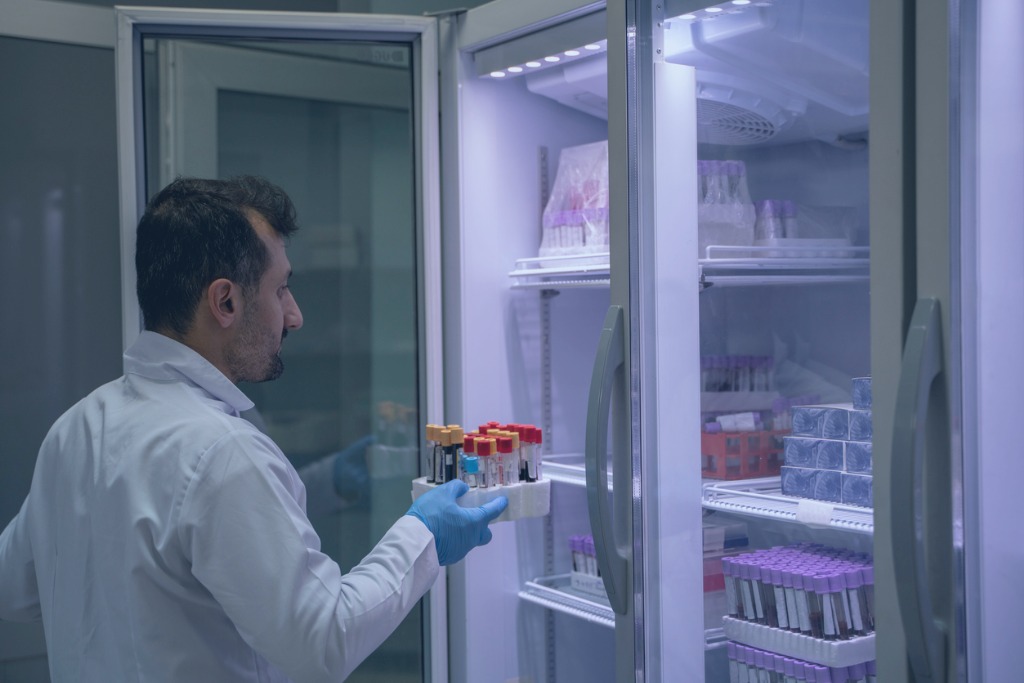When you choose Embraco original parts, you ensure optimum compressor efficiency and reliability and also guarantee the quality of your service. Denny Martin highlighted in this article the best practices when installing and troubleshooting parts and explained how to protect against overloading and overheating.
Basic Refrigeration System: 
Basic refrigeration systems that use fractional horsepower compressors use four primary components to move heat from an area that is not desirable to another area where the heat doesn’t create discomfort or impact the preservation of the product.
Compressor: The process starts at the compressor where superheated, low pressure vapor enters the compressor and through mechanical work, is compressed into a high pressure high temperature vapor, also known as a superheated vapor.
Condenser: This superheated vapor travels to the condenser where it is cooled by ambient air. As relatively cooler air passes across the condenser, it causes the gas to de-superheat and condense.. The waste heat is deposited in a surrounding area. As the gas cools past the saturation point of the fluid, it begins to condense, or turn into the liquid instead of a vapor. The phase change must complete in the condenser or else the system will not operate correctly. To ensure proper system operation the liquid should continue to cool below the saturated condition and become a subcooled liquid. This means the temperature of the liquid is below the saturated liquid temperature of the fluid. In most systems, this heat exchange is added by a fan blowing the ambient air over the condenser coil. Although the liquid line drier isn’t typically considered one of the four primary components of a basic refrigeration system, it’s a very important device that removes contaminants and residual moisture from the system and should be located in the liquid line right after the condenser. Another device that can be present in a refrigeration system is the receiver that acts as a refrigerant storage tank, where fluid is kept when ambient temperature is lower and less refrigerant is necessary in the system, for example during winter. In the summer, as the ambient temperature is normally higher, the system will need more refrigerant and it will use what was stored in the receiver.
Metering Device The metering device, or expansion device, is there to create a pressure drop in the liquid by creating a restriction in the flow of the fluid. This drop in pressure will cause the liquid to start boiling once it enters the evaporator. Common metering devices are capillary tubes and thermal expansion valves (TXVs).
Evaporator: After the metering devices, the fluid enters the evaporator where the fluid changes phase from a saturated liquid to a vapor (boiling). This boiling process absorbs heat from the space being cooled into the refrigerant fluid. In most systems, the heat exchange is added by blowing the air inside the cooled space over the evaporator coil with a fan. In a good system the temperature of the vapor should be a few degrees above the saturated temperature of the fluid to ensure that no liquid returns to the compressor. If liquid does return to the compressor it could damage it since liquids are incompressible fluids.
Primary Electrical Parts In Refrigeration Systems: Most fractional compressor refrigeration systems come equipped with the same basic electrical components used to start and protect the compressor. They also improve startability and efficiency.

Typically, there will be:
1. Start relay
2. Overload protector
3. Start capacitor
4. Run capacitor Start Relay.
The start relay turns the compressor on when the in-unit thermostat calls for cooling, then disconnects power when the desired box temperature has been reached. These relays can be an electromechanical style, like a current relay, or a solid-state PTC that has no moving parts.

Embraco designed a proprietary electronic relay that we use in most household applications. Our Timed Start Device (TSD) consumes no energy in the off cycle, reducing the compressor’s energy consumption.
Overload Protector: The overload protector plays a very important role when a compressor is subjected to events that can overheat and damage motor windings, like low voltage events or hard starting that cause very high current draw. There are 2 basic types of overload protectors. First, is the ¾” round, sometimes called a “Klixon.” This type has contacts mounted on a bimetal disc with a coiled heater wire underneath. High current draw and shell temperature cause the disc to deflect and open the contacts, removing power from the compressor.

The second is the more compact “4TM” type overload protector that works much in the same way but has a flat housing. Once the compressor has cooled enough, the disc will return to its original position, closing the contacts.
Start Capacitor: Start capacitors are usually included when extra starting torque is required, like TXV equipped systems or others that may tend to short cycle, which prevents pressure equalization in the off cycle. Start caps also benefit larger, single-phase compressors by reducing amp draw on startup.

Run Capacitors While start capacitors provide increased starting torque, “Run” capacitors provide increased running torque helping compressors consume less energy in operation. Typically run caps do not provide better starting ability, just more efficiency…with one exception. A permanent split capacitor (PSC) compressor, like most AC units use, may have a hard time starting with a bad run cap and sometimes may not start at all.

Why Is It Important To Have The Correct Part For Each Compressor? Manufacturers spend lots of time fine-tuning and testing electrical components to ensure their compressors operate at optimum efficiency and are protected against overloading and overheating. Relays are matched to the motors to provide the best starting characteristics and long-term reliability. Overload protectors are carefully designed and tuned to disconnect power to the compressor before the motor windings or insulation is permanently damaged. Start and run capacitor specifications are determined through lab tests to provide the best startability and running efficiency possible.
Benefits Of Using Embraco Service Parts: When a refrigeration technician chooses Embraco service parts, they are taking the best step to ensure the Embraco compressor they’re repairing or replacing will perform at factory levels of efficiency, capacity, and reliability.

Best Practices When Installing/Servicing Parts: There are a few things to keep in mind when replacing electrical components. Electrical connections should always be tight and corrosion free or there will be a risk of creating heat from higher amp draw. Relays and overloads should be firmly attached to compressor pins. When replacing a compressor always use new start components. Old parts can be worn and negatively affect the service life of the replacement. Embraco provides new components with all aftermarket replacement compressors. Generic electrical kits can be used to get equipment up and running but should be replaced with factory items when available. Because the overload device in these kits is designed for multiple horsepower motors, the factory specified parts are a better choice in most cases.
Troubleshooting Parts:

Current Relay: One of the most common start relays, the current relay, is characterized by the heavy copper wire wrapped around its body. This is the coil for this relay, and it operates off inrush current when the compressor starts. This coil is wired in series with the run winding and has normally open contacts. As the heavy current goes through the coil it pulls in a magnetic core, closing the contacts and energizing the start winding of the compressor. Once the compressor is running the heavy current falls off, allowing the contacts to open deenergizing the start winding. To check a current relay, you can measure continuity through the main and start terminals in the relays mounted position -there shouldn’t be any because the contacts should be open. Then turn the relay over and gravity should close the contacts. Be sure to check that there is resistance through the coil terminals.
Positive Temperature Coefficient Relay: The positive temperature coefficient relay (PTC) is also common. For a PTC, resistance rises with temperature rise. These are solid-state and operate using a pill made of material that has very low resistance at start up, allows the start winding to be energized. As soon as the compressor starts, the pill’s temperature and resistance rise quickly, effectively removing the start winding. These relays can be checked by measuring resistance through terminals 2 and 3, the start and run pin connections. The correct ohmic range can be found in charts provided by the manufacturer. Sometimes these relays will smell burned or can be shaken to listen for a broken pill.
Voltage Relay: On larger commercial compressors you will find a potential, sometimes called a voltage relay because they operate off the voltage or back electromotive force (EMF) created by the compressors start winding. These relays are normally closed, which energizes the start circuit. As the compressor starts back, EMF is generated by the start winding. A coil in the relay senses this voltage and as the compressor RPM increases, so does the back EMF. The relays are tuned to open the start circuit at about 75% compressor speed. This is where the term “pick up volts” comes from. At this voltage range the relay opens the start circuit contacts until the compressor shuts off. Then the contacts close again as the compressor spins down, ready for the next start up.
Overload Protector: The overload protector is a simple open or closed contact device, so checking for continuity through them will tell you if they’ve opened. If they have opened, the system should be checked for reasons why the compressor was overloaded. Time has to go by for the overload to close and this could be considerable if the compressor is overheated. Some cool, wet towels or a stream of water can be used to cool the compressor shell speeding the reset time Some overloads are internal in the motor windings. Be sure all power to the equipment is off and locked/tagged out. Once the overload resets be careful to run the system for short periods while looking for the cause of malfunction. And be ready to shut it off.
Meters: Capacitors can weaken over time, so it’s important to check them. Start and run capacitors can be open electrically, but typically the best way to check them is to use a meter with capacitance. Connect the meter to the terminals and check that the cap reaches the correct microfarad range. Some start caps have bleed resistors that may need to be disconnected and soldered back on after the test. It’s important to replace capacitors with the same voltage range or slightly higher. This is the rated voltage the cap can handle so a lower voltage should not be used.
Author: Denny Martin Co-author: John Prall



